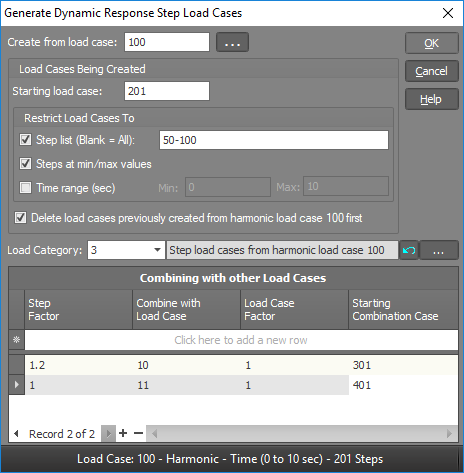Dynamic response step load case generation
In order to be able to use the results from a harmonic or transient response analysis in a practical way, you can convert any of the time steps to "step" load cases that contain displacements, forces, moments, stresses and reactions, just like you would get from a static analysis.
Note that step load cases cannot be
generated from a harmonic analysis that has used frequency sampling because
frequency sampling results come from a range of different points in time
and therefore do not represent an equilibrium state of the structure.
You can do this by selecting "Generate
Dynamic Response Step Load Cases" from the "Loads"
menu, choose the harmonic or transient load case that you want to create
the load cases from and then specify the starting load case number.

You must then decide which steps you want to convert to load cases. It
is usually a good idea to only convert the steps that correspond to peaks
or troughs in the structure's response, otherwise you may generate many
load cases that are of no use. You can specify a list of steps to be converted
or you can request SPACE GASS to search for the peaks and troughs by selecting
"Steps at min/max values". You can also limit the steps to a
specific time or frequency range. If you make your search too restrictive
then you may exclude all steps. Conversely, if you convert too many steps
to load cases then you may finish up with a huge number of unwanted load
cases.
The "Load category" field lets you specify which load category
the generated step load cases will go into. For more information refer
to "Load categories".
The table at the bottom of the form lets you create sequences of combination load cases that combine the generated step load cases with other non-harmonic/transient load cases such as static or spectral load cases.
In the above example, we are converting the results of harmonic load case 100 into step load cases starting at 201 that come from harmonic steps 50 to 100, and by ticking "Steps at min/max values" we are limiting it to the steps that correspond to peaks and troughs only. We are also creating two sequences of combination load cases starting at 301 and 401 respectively. The combinations starting at 301 combine the step load cases starting at 201 multiplied by 1.2 with load case 10 multiplied by 1.0 (ie. 301 = 1.2*201 + 1.0*10, 302 = 1.2*202 + 1.0*10,... etc). Similarly, the combinations starting at 401 combine the step load cases starting at 201 multiplied by 1.0 with load case 11 multiplied by 1.0 (ie. 401 = 1.0*201 + 1.0*11, 402 = 1.0*202 + 1.0*11,... etc).
Once the load cases and combinations have been generated then you can view them, get reports and use them in any of the design modules, just like any other load cases.
Note that the harmonic/transient step load cases and their combinations will be deleted if you make changes to the model, loads, masses or combination load cases, or do a dynamic frequency, harmonic response or transient response re-analysis. If this happens then you will have to re-generate them using the above procedure.
If you have a combination load case that combines static load cases with step load cases from a harmonic or transient response analysis then you must carefully check that the harmonic or transient step load cases actually exist before you use the results of the combination. If the harmonic/transient step load cases have been deleted (due to a model, load or mass change or a re-analysis) then the combination may just contain the results of the static load cases. Because SPACE GASS allows combination load cases to include non-existent load cases, it doesn't give any warnings or errors if the harmonic or transient step load cases are missing. It can't even detect that they are missing because they have no input data associated with them. One way for you to quickly check if combination load cases contain harmonic or transient analysis results is to look for "harmonic" or "transient" in the load case heading in analysis result reports (eg. "Load case 301 (LinComb+Harmonic)" or "Load case 301 (LinComb+Transient)" or "Load case 302 (Harmonic)" or "Load case 302 (Transient)").